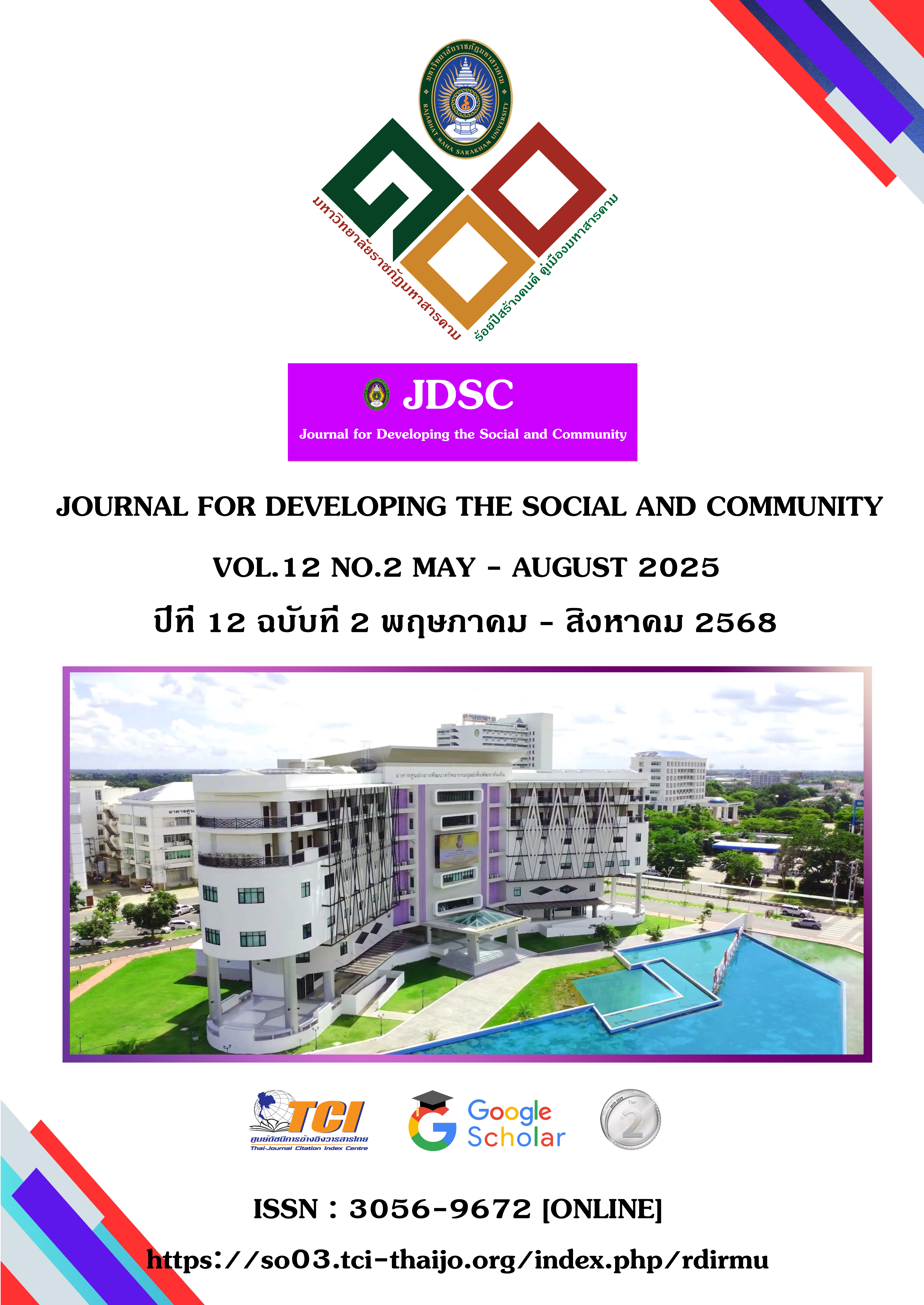Effects of Utilizing Design Thinking to Develop a Small Book River of Morality
Keywords:
Design Thinking, Small Book, Learning Media, Promote ReadingAbstract
Background and Aims: Increasing students' reading proficiency is a significant challenge for the Thai education system, which must improve all students' PBTS or PISA reading test scores to meet the required threshold. This research, therefore, has two main objectives: 1) to develop A Small Book River of Morality using the design thinking process and 2) to evaluate students' satisfaction after reading A Small Book River of Morality, which was developed using the design thinking process.
Methodology: This research used mixed methods research and was done using a style called concurrent transformative. There were 29 people who helped in the research. This group had 9 experts who checked the quality of the learning materials and 20 students who tried using the materials. The students were chosen by away called probability sampling using steps called multi-stage sampling. The research instruments included a quality assessment form for A Small Book River of Morality, developed using the design thinking process, and a student satisfaction assessment form regarding A Small Book River of Morality. The statistical methods used for data analysis were mean and standard deviation.
Results: 1) The quality assessment of A Small Book generated using the design thinking method yielded an overall average of 4.37 (S.D. 0.20), which can be viewed as highly appropriate. 2) The findings of student satisfaction with A Small Book generated through the design thinking process were equivalent to the overall average of 2.21 (S.D. 0.49), which can be considered as reasonably satisfactory.
Conclusion: The design thinking process can effectively facilitate the creation of booklets that promote reading skills and foster positive reading habits. Moreover, it contributes to enhanced user satisfaction, as the process is characterized by its systematic problem-solving approach, which aims to maximize benefits while ensuring both the creators’ and users’ engagement and satisfaction with the innovation.
References
Abd Elwahed, A. I. K., Seleim, S. I. M., & Mohammed, M. F. (2024). Design Thinking for Developing Creative Reading Skills of EFL Student-Teachers at the Faculty of Education in Helwan University. Journal of Educational and Social Studies, 30(6.2), 73–105. https://doi.org/10.21608/jsu.2024.379951
Asanok, M. (2018). Integrated Design Thinking for Instructional Innovation Development. Journal of Educational Technology and Communications Faculty of Education Mahasarakham University, 1(1), 6-12. https://so02.tci-thaijo.org/index.php/etcedumsujournal/article/view/242283
Bureau of Educational Innovation Development. (2024). Guidelines for Creating Mini-Books Based on the Anti-Corruption Education Curriculum for Basic Education, Additional Course: Corruption Prevention. https://shorturl.at/6ACv3
Equitable Education Fund. (2013). Analysis of PISA 2022 and the Future Direction of Thai Education Beyond 2025. https://www.eef.or.th/article-pisa-2022-00/
______ . (2022). Summary of the 2nd Asia-Pacific Ministerial Meeting on Education: Session 1. https://www.eef.or.th/news-learning-recovery-and-addressing-the-learning-crisis-160622/
Iemcharoen, P. (2024). Design Thinking for Creating Educational Innovations for Teachers in the Digital Age. Journal of Industrial Education, 23(2), 1-12. https://doi.org/10.55003/JIE.23203
Jamjuree, D. (2020). Learning Design for Gen Z Learners http://www.curriculumandlearning.com/.
Juniantari, M., Ulfa, S., & Praherdhiono, H. (2023). Design Thinking Approach in The Development of Cirgeo’s World Media. Jurnal Nasional Pendidikan Teknik Informatika : JANAPATI, 12(1), 42–55.
https://doi.org/10.23887/janapati.v12i1.55203
Kaewprasert, T., Chaisungnoen, C., Choicharoen, T. and Chana, K. Developing an Identity to Enable Teachers to Possess Innovative Teaching Abilities by Design Thinking. The 8th National Conference on Education for Learning Development 2024 (p.312-324). Faculty of Education, Suan Sunandha Rajabhat University.
Ketsing, W. (1995). Mean and Interpretation: Simple Issues That Are Sometimes Misunderstood. Educational Research News, 1(4), 13.
Klahan, P. and Ponegrn, W.. (2021). Development Learning Activities Based on a Design Thinking Process and Project Based Learning to Enhance Innovators in Grade 10 Students. Journal of Education Studies, 49(2), Article 13. https://digital.car.chula.ac.th/educujournal/vol49/iss2/13
Lasongyang, P. (2018). Thinking, Writing, and Creating: Tales and Children's Books. Bangkok: Chulalongkorn University Press.
Lidwell, W., Holden, K., & Butler, J. (2010). Universal Principles of Design. Rockport Publishers.
Ministry of Education. (2021). Higher-Order Thinking Competencies. https://cbethailand.com
Muangmoon, S., & Saikamfoo, J. (2020). The Development of a Booklet Through Augmented Reality to Develop Reading Skills for Grade 6 Primary School Students Under the Jurisdiction of Lampang Primary Education Service Area Office 1. Sripatum Chonburi Academic Journal, 16(3), 71-77. https://so05.tci-thaijo.org/index.php/SPUCJ/article/view/240814/163971
National Institute of Educational Testing Service. (2024). Analysis Report on the Basic Education National Test (O-NET) Results for Grade 6, Academic Year 2023, for Teaching and Learning Development. https://www.niets.or.th/th/catalog/view/497/50
______ . (2024). Basic Education National Test Report, Academic Year 2023. https://online.anyflip.com/hebbn/jwak/mobile/index.html
Office of the Basic Education Commission. (2024). The 72nd Student Handicraft and Arts Competition, Academic Year 2024. https://www.obec.go.th/archives/1076025
Onkhoksung, C. (1979). Educational Psychology. (2nd ed.). Bangkok: Thai Watthana Panich.
Pathumsuti, S. (2010). Analytical Reading Handbook. Bangkok: Nawsarn Publishing.
Rattana, B. (2023). APPLYING DESIGN THINKING THEORY IN ENGLISH LANGUAGE CLASS TO ENHANCE COMMUNICATION SKILLS IN CHILDHOOD LEARNERS. Academic Journal Phranakhon Rajabhat University, 14(1), 221–236. https://so01.tci-thaijo.org/index.php/AJPU/article/view/257604
Srisaard, B. (2010). Introduction to Research. Bangkok: Suweeriyasarn.
Thong-ngok, K.. (2022). The use of Design Thinking process to develop an augmented reality application to promote healthy foods. SCIENCE AND TECHNOLOGY RESEARCH JOURNAL NAKHON RATCHASIMA RAJABHAT UNIVERSITY, 7(2),14–20.
https://ph02.tci- thaijo.org/index.php/sciencenrrujournal/article/view/245140
Thongniam, S. (2017). Thai Language for Communication. Bangkok: SE-ED Education.
Tsai, S.-C.., Wang, S.-Y.., & Lai, H.-P.. (2022). Evaluating Learning Effectiveness towards Online Learning: Application of Design Thinking and Reading Comprehension for Case Reading on Economic Issues during COVID-19. International Journal of Education and Practice, 10(3), 287–299. https://doi.org/10.18488/61.v10i3.3143
Wongputtipong, P. (2020). Storytelling Structure Theory. https://pharmconnection.blogspot.com/2020/09/storytelling.html
Woraphan, A. (2003). Development of Reading and Writing Skills in Early Childhood Through Storytelling Activities and Mini-Book Creation. (Master's thesis). Bangkok: Srinakharinwirot University.
Downloads
Published
How to Cite
Issue
Section
License
Copyright (c) 2025 Journal for Developing the Social and Community

This work is licensed under a Creative Commons Attribution-NonCommercial-NoDerivatives 4.0 International License.
Articles that are published are copyrighted by the authors of the articles







